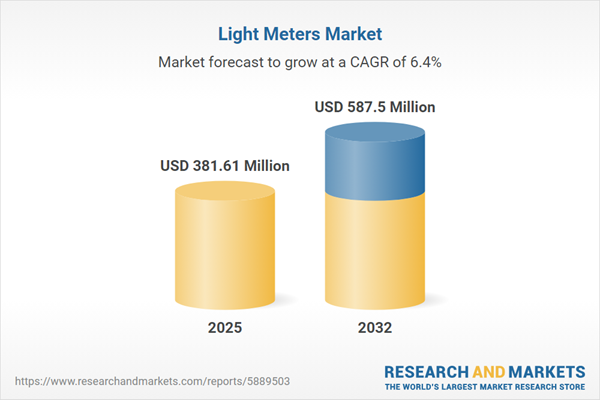Speak directly to the analyst to clarify any post sales queries you may have.
As illuminated environments become increasingly complex, senior leaders are seeking advanced light meters to drive compliance, efficiency, and risk management across their operations. Modern solutions now integrate seamlessly into organizational workflows, helping executives adapt to evolving safety and performance standards.
Market Snapshot: Growth and Outlook for the Light Meters Market
The global light meters market reached USD 358.50 million in 2024 and is anticipated to climb to USD 381.61 million by 2025, with a projection of USD 587.50 million in 2032, reflecting a compound annual growth rate (CAGR) of 6.36%. Driving this growth are innovations in sensor technology and the adoption of smart lighting systems, all supported by stringent regulatory frameworks. Light meters are increasingly central in facility planning, automotive calibration, and R&D initiatives, with analytics-driven and automated controls emerging as strategic focus areas across compliance-driven industries.
Scope & Segmentation: Strategic Framework for Senior Leadership
This report provides actionable segmentation for optimizing investment, procurement, and operational improvement in the light meters market. Understanding these segments empowers organizations to strengthen competitiveness, safety, and compliance programs.
- Product Types: Analog lux meters address specific industrial and field measurement requirements; digital lux meters offer enhanced precision and data connectivity for integration with business systems; foot-candle meters are trusted tools for maintaining regulatory compliance in workplaces; radiometers are indispensable for expanding measurement into UV and IR domains, supporting research and environmental controls.
- Applications: Commercial lighting design, construction compliance, automotive calibration, industrial efficiency monitoring, scientific research, and lighting management in creative and media settings.
- Distribution Channels: Global distributors, established retail chains, digital platforms, and direct manufacturer channels, each catering to diverse procurement and supply continuity goals for organizations worldwide.
- Technologies: Photon multiplier tubes enable high-sensitivity applications; photovoltaic cells deliver scalable, power-efficient instrumentation; silicon photodiodes provide consistent readings; thermal detectors are essential for accurate analysis in dynamic or challenging conditions.
- End User Segments: Manufacturing professionals, industrial operators, educators, institutional procurement specialists, and researchers dependent on validated measurement data.
- Power Sources: Alkaline and rechargeable batteries ensure mobility; AC/DC power supports permanent installations; solar-powered units foster sustainability in environmentally-conscious deployments.
- Connectivity Options: RS-232, USB, Bluetooth, NFC, and Wi-Fi support robust data transfer, system integration, and efficient device management.
- Geographical Coverage: Markets in the Americas, Europe, Middle East, Africa, and Asia-Pacific vary in procurement strategies, compliance demands, and supply chain complexities, offering both challenges and strategic opportunities for expansion.
- Leading Companies: Konica Minolta, Lutron Electronics, FLIR Systems, Sekonic, Gossen Foto- und Lichtmesstechnik, Testo SE & Co. KGaA, Tenmars Electronics, Amprobe Test Tools, Extech Instruments, and TES Electrical Electronic exemplify advancement in industry standards and solution delivery.
Key Takeaways: Strategic Insights for Executive Decision-Makers
- Digital light meters improve workflow efficiency and support organizational goals for safe, consistent environments by standardizing lighting conditions.
- Integrated sensor platforms allow for automated and remote lighting management, advancing smart building initiatives and adaptive manufacturing standards.
- Procurement teams must regularly assess sourcing models, as regulatory shifts in sectors like construction and automotive can alter compliance pressures and supply base requirements.
- Compact and portable meter solutions enable on-site stakeholders, including educators, to adapt measurement strategies for diverse real-world settings.
- Regional procurement shifts emphasize energy efficiency and automation in North America and Europe, infrastructure scalability in the Middle East, and rapid manufacturing advances across Asia-Pacific.
- Analytics and enhanced connectivity help facility managers improve lighting system reliability, aligning with evolving risk management and compliance protocols.
Tariff Impact: Adjusting to Supply Chain and Pricing Developments
Tariff changes in 2025 are expected to impact global supply chains and cost structures for light meter manufacturers. Industry leaders are taking steps to diversify supplier relationships and refine distribution strategies, ensuring proactive procurement planning and responsive logistics to safeguard against pricing uncertainty and maintain supply continuity.
Methodology & Data Sources
This analysis combines executive interviews, direct end-user input, peer-reviewed literature, and patent filing reviews. Findings are validated through industry-standard datasets and secondary sources to deliver reliable, evidence-based insights for the light meters market.
Why This Report Matters
- Supports senior leadership in optimizing digital sourcing and investment strategies within dynamic industry conditions.
- Clarifies the influence of regulatory changes, new technology, and evolving supply chains on procurement and compliance frameworks.
- Equips decision-makers with relevant, actionable analysis for standards-aligned measurement solutions across the light meters industry.
Conclusion
Continual advancements in compliance and innovation are shaping the future for light meters. Access to robust market intelligence empowers executive teams to build reliable operations and long-term strategies for resilience and growth.
Additional Product Information:
- Purchase of this report includes 1 year online access with quarterly updates.
- This report can be updated on request. Please contact our Customer Experience team using the Ask a Question widget on our website.
Table of Contents
3. Executive Summary
4. Market Overview
7. Cumulative Impact of Artificial Intelligence 2025
Companies Mentioned
The companies profiled in this Light Meters market report include:- Konica Minolta, Inc.
- Lutron Electronics Co., Inc.
- FLIR Systems, Inc.
- Sekonic Corporation
- Gossen Foto- und Lichtmesstechnik GmbH
- Testo SE & Co. KGaA
- Tenmars Electronics Co., Ltd.
- Amprobe Test Tools
- Extech Instruments Corporation
- TES Electrical Electronic Corp.
Table Information
| Report Attribute | Details |
|---|---|
| No. of Pages | 184 |
| Published | October 2025 |
| Forecast Period | 2025 - 2032 |
| Estimated Market Value ( USD | $ 381.61 Million |
| Forecasted Market Value ( USD | $ 587.5 Million |
| Compound Annual Growth Rate | 6.3% |
| Regions Covered | Global |
| No. of Companies Mentioned | 11 |









